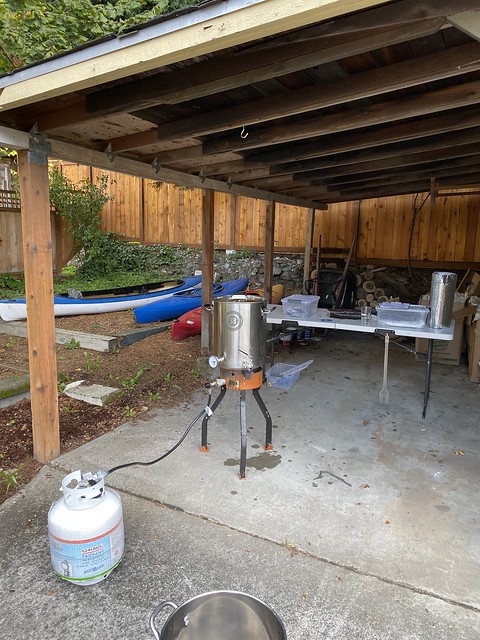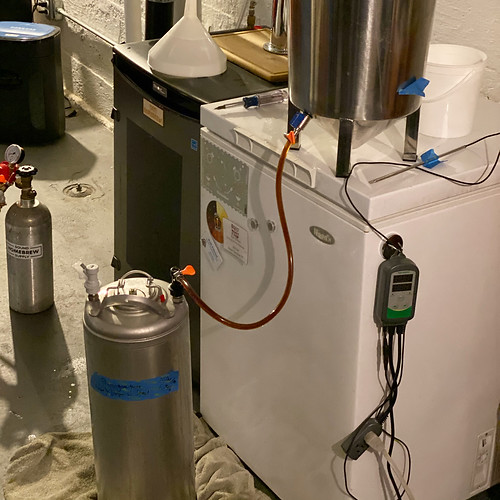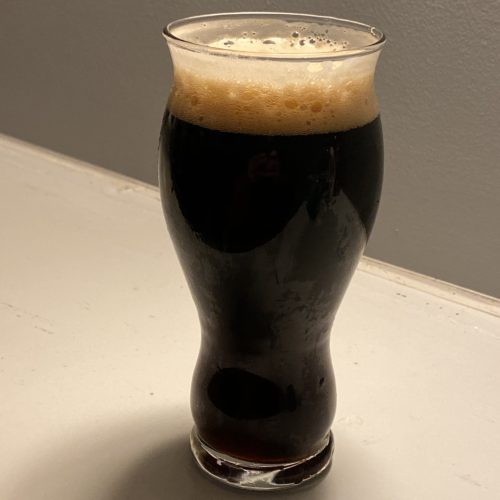Homebrew #89: Primogeniture
¶ by Rob FrieselAfter a four-and-a-half month 1 (forced) hiatus, I got myself brewing again. 2 I needed to get at least one brew day in before I went back to work, after all.
New state? New space? New water? New homebrew supply store? Throw caution to the wind. Set your sights on an Imperial Stout and see what happens. Go big or go home, right? And this gives us Primogeniture:

I’d thought about trying to ease into my Seattle brewing experience with something… less challenging? But when I asked A. what she would like to see for my first homebrew in the new house, she expressed a strong opinion. Something dark and something strong.
Now, my data tell me that my bigger beers have a tendency to fall short of their target gravities, and I haven’t been able to figure out why. 3 Nevertheless, the seed was planted, and a “very nearly” Imperial Stout was on the agenda.
Following my usual procedure, I made a mental map of the flavor profile, made an initial sketch of the formulation, compared that against some respectable prior art, made some tweaks, and did my shopping.
Can I just say how nice it is to live now where Imperial Yeast is so abundant?

Brew Day
I’ll admit that I was spoiled in my Vermont house, but there’s a serviceable space to work with here in Seattle.

SPOILER ALERT: A bunch of things went… slightly sideways this day.
FIRST: I forgot that I didn’t have a lighter. I managed to find some long matches and, while lighting the burner that way was sketchy, it worked.
SECOND: My hose was just barely too short for the space I’d scoped out. I mean… I’d measured everything but I guess measurements can be deceiving? I needed about four more feed to be able to fill the kettle. Luckily I could just fill my smaller secondary kettle and dump. (Problem solved… for now.)
OK we’re finally brewing, right? Or at least mashing. 4
Let the enzymes do their thing (or as much of it as they cared to) and then it’s time to hoist the bag…
THIRD: The bottom of the bag hung down maybe 1-2 inches below the rim of the kettle — and that was with the hoist pulled up all the way. I had to hold the bag up myself and slip my grill grate underneath of it and then keep both (gloved) hands on it while it drained and I squeezed — so that it wouldn’t fall off. Granted this wasn’t all that different from my winter-time kitchen brewing back in VT… but still.
Having collected my wort, it was time to get the flame going again. But… what about the chiller? With the hose being too short, I had to carefully move everything out from under the carport … and onto the slight angle of the driveway! But at least now the hose would reach.

I’d say I was mostly incident free after that… Did my 60 minute boil. Ran the chiller and… I guess just spray that water out into the yard.
Run off approximately 5.3 gallons of wort into the Brew Bucket with a starting gravity of 1.071.

Which hey… only about five points shy of my target 1.076. I’ve certainly done worse.
Fermentation
The chiller got the wort down to 84 ºF after about 10 minutes; another hour or so in the fermentation chamber got it down below 64 ºF. It’s at this point that I pitched the two packs of A10 Darkness, and locked in my controller at 63±1 ºF.
Activity in the blow off started within a few hours and just ticked up steadily for several days. I took the first gravity reading at +76 hours. The refractometer reported 9.6 ºBx which BeerSmith converted to 1.018.
Given that it finished at 1.019 5, it’s probably safe to say that Darkness ripped through this wort and got it to F.G. in 3 days. Just the same, I brought the temperatures up a few degrees at a time for a diacetyl rest.
My October schedule being what it was… it was about three weeks after the brew day before I got this one into a keg.

Kept oxygen out as best I could 6 and purged that headspace, then put it on 35 PSI for 24 hours. Lowered that to 15 PSI and let it settle and condition another couple days after that.
Overall Impressions
Far from my best work, but also pretty far from my worst.

AROMA. Medium-low cocoa; moderate caramel; low roasted grain character. Low piney hop presence; background spicy and maybe slightly woodsy. Subtle but distinct dried black cherry ester note. No significant alcohol. No significant acetaldehyde, nor diacetyl, nor DMS.
APPEARANCE. Very dark brown, nearly black; walnut highlights. Light tan head of dense creamy foam; average retention. Opaque.
FLAVOR. Malt character leads with medium-high bittersweet chocolate and medium biscuit; moderate caramel, moderate roasted grain. Hop character medium piney and lightly citrusy (like ripe orange flesh). As with aroma, subtle but distinct ester evocative of black cherry; gives an almost “cherry cola” impression. Medium bitterness lingering into the finish. Off-dry. Aftertaste of chocolatey malt and hop bitterness.
MOUTHFEEL. Medium-full body. Medium carbonation. Moderate creaminess. Soft and just-perceptible alcohol warming. Light astringency congruent with roasted grain character.
OVERALL IMPRESSION. Good (maybe very good?) example of the style if scoring as 20B. American Stout; likely just “fair” if judged as 20C. Imperial Stout. I’m not picking up any obvious technical faults, though the body seems a little light which suggests the mash schedule didn’t quite land where it was supposed to. Aroma and flavor characteristics work well together, but seem to be lacking in the boldness you’d expect from a beer that’s supposed to be “very nearly” Imperial. It’s like it needs just a little bit more of everything: bitterness, malt character, hop character, alcohol…
When I say I’m not disappointed, it’s not because I nailed it — but because of all the things that could have gone wrong and all of the things that actually did go wrong while brewing this beer. In other words — it could have been a complete train wreck, and instead it’s a drinkable-if-slightly-disappointing beer. High five!
What would I do differently next time?
First off: I need to dial in the ergonomics of my new brew space. I’ve lowered my burner to get better clearance when hoisting the bag. I bought another 25′ length of food-safe hose. I’m sure there are some other tweaks that I’ll figure out over the next few brew days, but those were the essentials for next time.
As for this specific recipe…
I need to figure out what the deal is with my decreased brew house efficiency on these bigger beers. Where is the inflection point? Can I compute some kind of curve for the drop-off? Or is there something else in the process I can control to decrease or eliminate that drop-off?
How about boosting all of the flavors? Given that this was intended as a (nearly) Imperial Stout, it falls short more or less across the board. Tweaks to the grist? Less time in the fermentor? Fresher ingredients? 7 A dry-hop charge?
Hard to say without feedback.
Nevertheless, it’s a drinkable stout, and not bad for a first showing here in Seattle.
Recipe
The all-grain (BIAB) recipe for Primogeniture is as follows:
Water Chemistry
Starting with the Seattle public water profile as a base:
- 0.62 g/gal. baking soda
- 0.38 g/gal. Epsom salt
- 0.35 g/gal. calcium chloride
- 0.30 g/gal. calcium sulfate
| Ca | Mg | Na | SO4²- | Cl- | HCO3- |
|---|---|---|---|---|---|
| 51.1 | 10.5 | 46.0 | 85.1 | 47.3 | 140.1 |
Mash Grains
- 8 lb. Briess 2-row Brewers Malt
- 4 lb. Avangard Munich Malt
- 1 lb. Briess Chocolate Malt
- 8 oz. Briess Caramel 60L Malt
- 8 oz. Briess Roasted Barley
- 4 oz. Briess Caramel 80L Malt
- 2 oz. Briess Caramel 120L Malt
Hop Schedule
- 1.25 oz. Warrior (60 min.)
- 2 oz. Chinook (0 min.)
Yeast
2 × packages Imperial A10 Darkness
Brew Day
- Collect 31.54 qt. water and heat to 161.2 ºF. Mash in; hold at 152 ºF for 60 minutes. No mash out.
- Remove filter bag from water. Squeeze filter bag to extract as much liquid as possible for wort. No sparge. Pre-boil volume should be 6.83 gallons.
- Bring to a boil. Boil for 60 minutes; follow hop schedule as described above.
- Cool to 64 ºF as rapidly as possible. Post-boil volume should be approx. 5.25 gallons.
- Aerate wort; pitch A10 Darkness yeast.
- Start fermentation at 64±1 ºF.
Beyond Brew Day
- Allow fermentation to complete (approx. 2 weeks) at approx. 64±1 ºF.
- Raise to a diacetyl rest (70±1 ºF) for approx. 3 days as fermentation activity dies down.
- Transfer to a keg.
- Force carbonate to 2.5 volumes.
- Enjoy!
Details
Primogeniture, a Nearly Imperial Stout by Tilde Gravitywerks
| Original Gravity | 1.071 |
| Final Gravity | 1.019 |
| ABV | 6.9% |
| Attenuation | 72.1% |
| IBU | 62 |
| SRM | 40 |
| Links | Flickr Untappd |
- Bearing in mind that the longest hiatus before this one was only about two months, and that was the gap between brew #1 and brew #2.[↩]
- And what a 180º from my last brew.[↩]
- I’ve heard that bigger grain bills can have problems with efficiency, but I’ve never seen an explanation that ties it all together. I’ve got my own ideas here, and some of it has to do with my system, and some of it to do with generalizable brewing science … but that’s a digression for another day.[↩]
- I’m going to leave out the part where one of the Acco clips fell into the mash.[↩]
- Semi-ironically the target F.G.?[↩]
- Which… I’m far from a closed transfer system but oh well. We do what we can?[↩]
- I’m reasonably certain the grains were pretty fresh. The hops, in retrospect, were discounted 2018 crop… a little bit mea culpa there, but can you blame a guy for trying to save a few bucks? Maybe doubling up on the bittering addition could have saved that aspect. Not sure if more hops would have boosted the flavor component otherwise.[↩]
About Rob Friesel
Software engineer by day. Science fiction writer by night. Weekend homebrewer, beer educator at Black Flannel, and Certified Cicerone. Author of The PhantomJS Cookbook and a short story in Please Do Not Remove. View all posts by Rob Friesel →2 Responses to Homebrew #89: Primogeniture
Pingback: Homebrew #92: Clone in the Window (Mk. II) | found drama
Leave a Reply